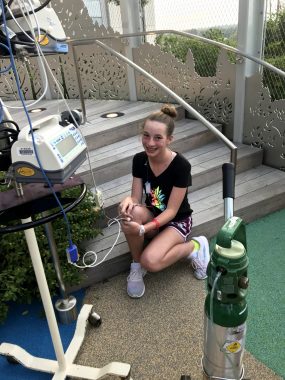30 Days of PH: Our Journey From Diagnosis to Potts Shunt Surgery

Dakota was diagnosed with pulmonary hypertension at age 6. (Photo courtesy of Laura Schonlau)
Day 3 of 30
This is Laura Schonlau’s story:
My daughter was diagnosed with pulmonary hypertension (PH) when she was 6. She is now 18. Although she has suffered all the pain and misfortune of this disease, we share the journey living with PH and the hardship. Endless nights of worrying, sleeping in a hospital chair for days on end, and all the scheduling, record-keeping, medicine-ordering, and pharmacy work! We are a team in this fight.
Dakota started her PH journey with triple therapy: ambrisentan, sildenafil, and Tyvaso (inhaled remodulin). She then went on to try an extended release oral brand of treprostinil. It was a nightmare. That led to the dreaded IV remodulin. We decided to go the IV route because of the pain associated with the subcutaneous injections.
In 2018, Dakota started declining. Her numbers were worse, her exercise tolerance declined, and she was struggling. Our doctors could not pinpoint the reason, and it was terrifying. Two options were left: Lung and possibly heart transplant, or the very new, very experimental Potts shunt surgery. So, in July 2018 we were off to St. Louis, Missouri, for the evaluation for both.
It was an exhausting week of testing, labs, doctors, and information overload! We had great news though. Dakota was still too healthy for a transplant and she did qualify for the new Potts shunt procedure.
A Potts shunt is a side-to-side connection from the left pulmonary artery to the descending aorta, which diverts some of the high pressure out of the body without having to go through the lungs. It acts like a “pop-off” valve for the right ventricle, giving it some much-needed relief.
We spent the next few months praying and preparing for the surgery, scheduled for October 2018. The doctor, Dr. Pirooz Eghtesady, MD, PhD, had performed less than 20 of the surgeries at that time.
Even though it was extremely painful, Dakota sailed through the surgery and recovery. It took her nearly a year after the surgery to recover fully, and almost two years to see the full benefits. Now, in 2022, she is getting ready to transition to Uptravi and hopefully will be able to remove her IV line completely.
Pulmonary Hypertension News’ 30 Days of PH campaign will publish one story per day for PH Awareness Month in November. Follow us on Facebook and Instagram for more stories like this, using the hashtag #30DaysofPH, or read the full series.







